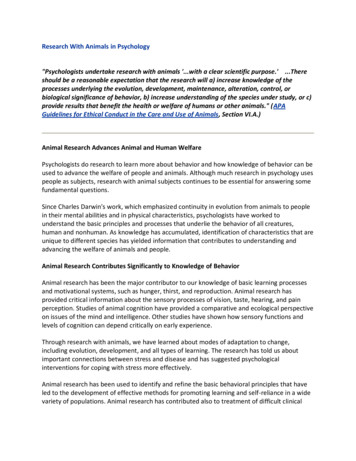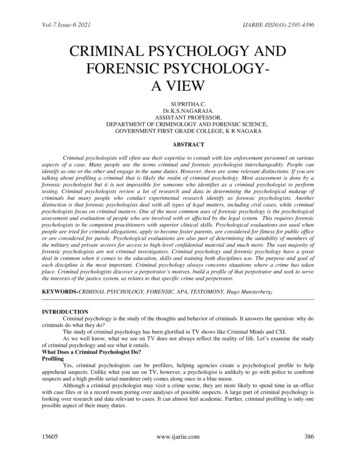
Transcription
Research With Animals in Psychology"Psychologists undertake research with animals '.with a clear scientific purpose.' .Thereshould be a reasonable expectation that the research will a) increase knowledge of theprocesses underlying the evolution, development, maintenance, alteration, control, orbiological significance of behavior, b) increase understanding of the species under study, or c)provide results that benefit the health or welfare of humans or other animals." (APAGuidelines for Ethical Conduct in the Care and Use of Animals, Section VI.A.)Animal Research Advances Animal and Human WelfarePsychologists do research to learn more about behavior and how knowledge of behavior can beused to advance the welfare of people and animals. Although much research in psychology usespeople as subjects, research with animal subjects continues to be essential for answering somefundamental questions.Since Charles Darwin's work, which emphasized continuity in evolution from animals to peoplein their mental abilities and in physical characteristics, psychologists have worked tounderstand the basic principles and processes that underlie the behavior of all creatures,human and nonhuman. As knowledge has accumulated, identification of characteristics that areunique to different species has yielded information that contributes to understanding andadvancing the welfare of animals and people.Animal Research Contributes Significantly to Knowledge of BehaviorAnimal research has been the major contributor to our knowledge of basic learning processesand motivational systems, such as hunger, thirst, and reproduction. Animal research hasprovided critical information about the sensory processes of vision, taste, hearing, and painperception. Studies of animal cognition have provided a comparative and ecological perspectiveon issues of the mind and intelligence. Other studies have shown how sensory functions andlevels of cognition can depend critically on early experience.Through research with animals, we have learned about modes of adaptation to change,including evolution, development, and all types of learning. The research has told us aboutimportant connections between stress and disease and has suggested psychologicalinterventions for coping with stress more effectively.Animal research has been used to identify and refine the basic behavioral principles that haveled to the development of effective methods for promoting learning and self-reliance in a widevariety of populations. Animal research has contributed also to treatment of difficult clinical
problems such as controlling self- injurious behavior in autistic children and adults and teachingchildren who have been tube-fed since birth to eat normally.Animal behavioral research has been fundamental to understanding the range of behavioraleffects of psychoactive drugs and environmental toxicants. Behavioral research bypsychologists has contributed significantly to our understanding of drug abuse and physicaldependence. Behavioral research with specifically bred strains of mice and rats is contributingimportantly to understanding the nature and extent of genetic vulnerability to drugdependence.On other fronts, psychologists have developed behavioral methods for screening compounds inlaboratory animals and are active in developing new drugs used in the treatment of suchdisorders as anxiety, schizophrenia, and depression. Animal research is critical to current effortsto develop effective pharmacologic treatments for drug dependence and for the cognitivedeficits of aging and Alzheimer's disease.Animal research also has contributed to efforts to help animals, such as in programs toreestablish populations of endangered or threatened species, in designing appropriate livingconditions and enhancing the well-being of captive animals, and in developing humanemethods of animal control in the wild.Animal Research Helps Explain the Central Nervous SystemAlthough experiences in the world shape behavior, understanding how the nervous systemworks is critical to a complete understanding of behavior, including behaviors that areproblematic in mental illness, memory disorders, and drug addiction. Much of what we knowabout the relationships among anatomy, physiology, and behavior has come from animalresearch. Recent research on the brain, particularly on processes of chemicalneurotransmission, combined with behavioral research in animals has provided enormous leapsforward in our understanding of the functioning of the central nervous system. This informationis critical to understanding:the process of recovery after neural damage;biological correlates of fear, anxiety, and other forms of stress;subjective and dependence-producing effects of psychotropic drugs;mechanisms that control eating and other motivational processes; andthe biology of learning and memory.Psychologists who conduct animal research have contributed to the study of all these areas ontheir own and in fruitful and dynamic collaboration and dialogue with biologists, chemists,molecular biologists, pharmacologists, and physicians.
Human Subjects and Alternatives to Live Subjects Have Been ProposedVarious alternatives to research with animals have been proposed, including the use of plantsand tissue cultures and the use of computer simulations. In fact, all who do research withanimals are required, legally and ethically, to consider the possibility of using alternatives tononhuman animals. Animal laboratories are expensive and labor intensive to maintain;practically speaking, alternative methods could be an advantage.However, alternatives are often unavailable or inadequate. Plants lack a nervous system andtherefore cannot be used to learn about psychological phenomena. Tissue cultures cannotdevelop depression, alcoholism, autism, learning disorders, memory impairments, aggressivebehavior, social abnormalities, or other psychologically relevant problems. To be useful,computer simulations have to be based on knowledge obtained from live behaving organisms,and, therefore, cannot substitute for studies of live animals. Many fundamental researchquestions cannot be addressed without the use of intact functioning organisms. Even when analternative method generates useful information, however, the behavioral relevance of thatinformation ultimately must be determined in a living organism.Studies typically use animals when time requirements, risk, the need to control behavioralhistory, or other conditions make it impossible to use humans or when there are other practicalor ethical reasons not to use humans. For example:In psychopharmacology research, study of the behavioral effects of a chronically administereddrug and its withdrawal requires many days or weeks of daily drug administration. Many drugsof interest are under development and not yet approved for use in humans. Some studies mayrequire examination of brain tissue after drug treatment or require administration of drugs tospecific sites in the brain to help understand their mechanisms of action.Investigations into the process of aging are not practical with humans, who live 75 to 80 years.Scientists can get important insights into some aspects of aging by studying rats, which live anaverage of 2 years, or monkeys, which live 15 to 20 years, because the shorter lifespan yieldsmore quickly crucial data on aging.Experiments may require subjects of a particular size, age, or genetic makeup; they may restrictsubjects to special diets or require environmental control or even particular behavioralhistories. Studies of this sort would not be possible with humans.It has also been suggested that animals be studied in the wild rather than in the laboratory.Psychologists do observe and study animals in natural environments; but for manyinvestigations, the laboratory is the only setting in which causal variables can be isolated withsufficient precision to generate meaningful conclusions. The laboratory is often the onlypossible setting for investigating effects of drugs, chemicals, or pollutants.
Animals Used in Psychological Research VaryAbout 7-8% of psychological research involves the use of animals. Although the range of speciesthat have been used in various studies in psychology is broad, 90% of the animals used havebeen rodents and birds, principally rats, mice, and pigeons. Only about 5% of the animals aremonkeys and other primates. Use of dogs or cats is rare.Humane Care and Use of Animals in Research Are SafeguardedMany safeguards exist to assure that laboratory animals receive humane and ethical treatment.Care and use of animals in research are regulated and monitored by various governmentagencies. Institutions in which research with animals is conducted have federally mandatedreview committees.Federal Regulations and Guidelines ExistThe Animal Welfare Act, most recently amended in 1985, governs the care and use of manyresearch animals. The U.S. Department of Agriculture is responsible for enforcing the Act andconducting periodic unannounced inspections of animal research facilities, both public andprivate. In addition, institutions that conduct research using animals covered by the Act arerequired to have an Institutional Animal Care and Use Committee (IACUC) to review eachresearch protocol. The IACUC is required to include both a veterinarian and a local communitymember who is not affiliated with the institution. Animals may not be obtained and studiesmay not be conducted unless the IACUC has approved the protocol for its adherence to Federalguidelines for appropriate and humane use of animals. The IACUC must also maintain recordsabout the use of animals at the institution and conduct periodic inspections of its own.In preparing protocols for review by the IACUC, researchers must consider not only therationale for their experiments and the conditions of animal care during the experiment, butalso the rationale for the number of animals that they will use and whether or not this numberis appropriate for the proper interpretation of the results. They are required to be familiar withthe literature to assure that the research is not unnecessarily duplicative of previous studies.Furthermore, they are required to identify and address explicitly issues of pain and sufferingthat might be involved in their experiments and suitable approaches for alleviating any pain orsuffering.The Public Health Service has set guidelines that all recipients of grants from the NationalInstitutes of Health (NIH), the major source of funding for behavioral and biomedical researchwith animals, must follow. These guidelines apply to species such as rats, mice, and birds, notcovered by the USDA regulations.
The Scientific Community Also Sets StandardsThe American Association for the Accreditation of Laboratory Animal Care (AAALAC) isnationally and internationally recognized for its institutional accreditation program. AAALACsets the 'Gold Standard' for laboratory animal care and serves as a guide for those researchfacilities seeking to assure the best conditions for their research animals. Once accreditation isobtained, thorough inspections are conducted every 3 years to determine whether aninstitution may retain its accreditation.Professional societies whose members conduct animal research, such as the Society forNeuroscience and the Federation of Societies of Experimental Biology, also have ethicalstandards and guidelines to which their members must adhere. Virtually all journals thatpublish animal research require that the authors affirm that the research was done inaccordance with particular ethical standards.APA Ethics Code and Other Guidelines Cover Treatment of Research AnimalsThe APA Ethical Principles of Psychologists and Code of Conduct includes principles for thehumane and ethical treatment of research animals. All APA members are committed to upholdthese principles. Failure to do so can lead to expulsion from the Association. In addition, APA'sGuidelines for Ethical Conduct in the Care and Use of Animals sets comprehensive standards forpsychologists who use animals in their research. All individuals who publish in APA journals arerequired to conduct their research with animals in accordance with these guidelines.Contact APA for More InformationFor more information about the use of animals in psychological research, please contact:Research Ethics OfficerScience DirectorateAmerican Psychological Association750 First Street, NEWashington, DC 20002-4242Phone: 202-336-6000Fax: 202-336-5953Email: science@apa.org
Humane Care and Use of Animals in Research Are Safeguarded Many safeguards exist to assure that laboratory animals receive humane and ethical treatment. Care and use of animals in research are regulated and monitored by various government agencies. Institutions in which research with animals is conducted have federally mandated review committees.










